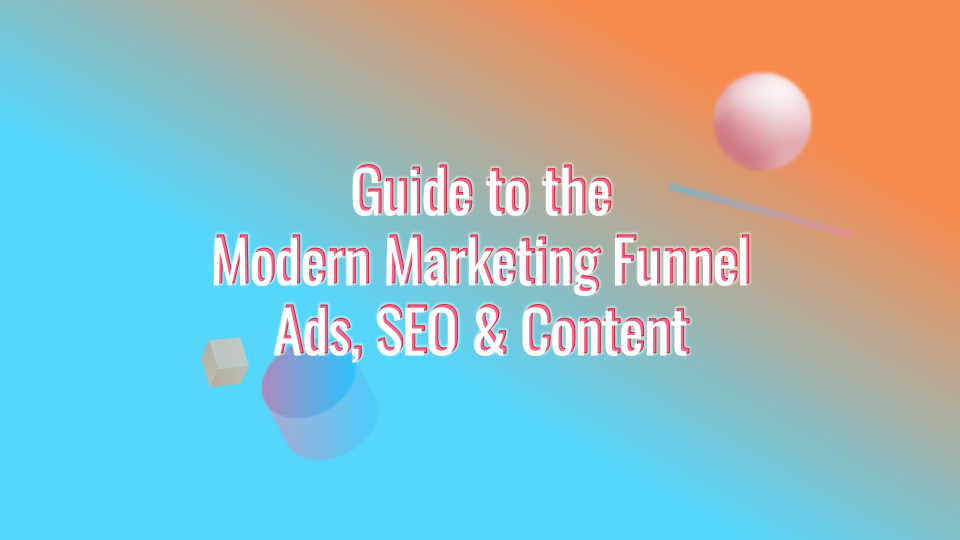The Modern Marketing Funnel: Integrating Paid Ads, SEO, and Content for a Seamless Customer Journey
A successful digital strategy doesn’t treat its channels like separate islands. Paid ads, SEO, and content must work together to guide customers from their first interaction with your brand to their final purchase and beyond. The marketing funnel provides the perfect map for this journey.
To help you build this integrated approach, this article will answer several key questions:
What is the modern marketing funnel and why is it important?
How do you use paid ads, SEO, and content at the Awareness stage?
First, What is the Modern Marketing Funnel?
The modern marketing funnel is a strategic model that visualizes the customer journey through four key stages: Awareness, Consideration, Conversion, and Loyalty. Unlike older models that ended at the sale, the modern funnel recognizes that retaining a customer is just as important as acquiring one. By mapping your marketing activities to each stage, you can create a seamless experience that effectively nurtures leads and builds lasting relationships.
Stage 1: Awareness – How Do Customers Discover You?
At this top stage of the funnel, the goal is to attract a broad audience and introduce them to your brand. Customers at this stage are not yet ready to buy; they are simply identifying a problem or a need.
Paid Ads: Use Display Ads and Video Ads on platforms like YouTube and social media to build broad brand recognition. The goal here is reach and impressions, not direct sales.
Content: Create educational, top-of-funnel content like blog posts, infographics, and short videos that address common pain points your audience faces. For example, a cybersecurity company might create a blog post titled, "5 Common Signs Your Business Is at Risk for a Data Breach."
SEO: Focus on broad, informational keywords that potential customers might search for when they are first learning about a problem. Optimizing your educational content for these terms will attract organic traffic from users who are just starting their research.
Stage 2: Consideration – How Do You Show You’re the Best Solution?
In the middle of the funnel, potential customers are actively researching and comparing different solutions. Your goal is to provide them with detailed information that positions your brand as the best choice and builds trust.
Paid Ads: Use remarketing campaigns to show targeted ads to users who have already visited your website. Social media ads promoting detailed case studies or webinar sign-ups are also highly effective at this stage.
Content: Develop in-depth content that demonstrates your expertise. This includes detailed guides, e-books, case studies, comparison articles, and webinars. This content should directly compare your solution to others or provide a deep dive into how your product solves a specific problem.
SEO: Target more specific, long-tail keywords that indicate a user is comparing options (e.g., "[Your Product] vs. [Competitor Product]" or "best software for small business accounting"). This ensures your in-depth content is found by users who are ready for detailed information.
Stage 3: Conversion – How Do You Close the Deal?
At the bottom of the funnel, the customer is ready to make a purchase. Your marketing efforts should be focused on making this final step as easy and compelling as possible.
Paid Ads: Run highly targeted Search Ads for branded and high-intent buying keywords (e.g., "buy [Your Product]" or "[Your Brand] pricing"). Remarketing ads with special offers or discounts can provide the final push needed to convert.
Content: Your website's product pages, pricing pages, and customer testimonials are your key content assets here. Ensure they are clear, persuasive, and answer any final questions a customer might have. A clear and simple checkout process is also critical.
SEO: Optimize your product and service pages for transactional keywords. Ensure your site's technical SEO is flawless to provide a fast and secure user experience, which is crucial for building trust at the point of purchase.
Stage 4: Loyalty – How Do You Keep Customers Coming Back?
The modern funnel doesn't end at the sale. This final stage is about retaining customers and turning them into brand advocates. Loyal customers are more profitable and can become a powerful marketing channel through word-of-mouth.
Paid Ads: Use remarketing lists to run targeted campaigns for existing customers, promoting new features, complementary products, or loyalty rewards.
Content: Nurture your relationship with customers through exclusive content, email newsletters with valuable tips, and a strong community presence (e.g., a user group on social media). Help guides and a comprehensive knowledge base are also essential for customer support and satisfaction.
SEO: While not a direct driver of loyalty, a well-optimized blog and help center that provide ongoing value will keep customers returning to your site, reinforcing your brand's authority and usefulness.
Conclusion: Building a Unified Customer Journey
By strategically integrating your paid ads, SEO, and content across the four stages of the marketing funnel, you create a powerful, unified system. Each channel supports the others, guiding customers smoothly from initial awareness to long-term loyalty. This approach not only improves your marketing ROI but also builds a stronger, more resilient brand.
Ready to build a seamless customer journey that drives growth? Contact us today for a consultation to learn how our integrated Digital Marketing services can help you build your perfect funnel.


